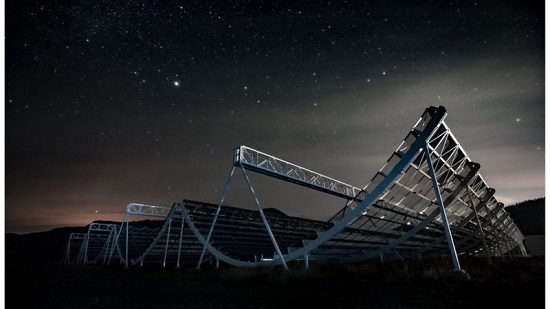At last, we re making headway in deciphering some of the Universe s most enigmatic signals.
Scientists have managed to trace a very short, very bright burst of radio waves to a type of highly magnetised dead star, known as a magnetar.
It s the first time a so-called fast radio burst, or FRB, has been pinned on a specific source.
FRBs were first detected in 2007, and have been one of the hottest topics in astronomy ever since.
The new discovery, reported in the journal Nature, was made by two independent radio telescope arrays in North America.
Co-incident observations by other astronomical facilities - both in space and on the ground - helped characterise the event and strengthen the interpretation.
The source magnetar, a known object, has the slightly unwieldy designation of SGR 1935+2154.
It s about 30,000 light-years away, which is interesting because all previous FRB detections have come from beyond our Milky Way galaxy.
The detected properties, however, are very much same.
Luminous event
The event itself occurred on 28 April this year. It lasted around a millisecond but was extremely luminous.
"We were able to determine that the energy dispersed is comparable to the energies of extra-galactic fast radio bursts, and in about one millisecond, this magnetar emitted as much energy in radio waves as [our] Sun does in 30 seconds," explained Christopher Bochenek, who led the design and construction of the Stare2 radio receiver network which is spread across California and Utah.
Even as far back 2007, magnetars were a prime suspect for the origin of FRBs.
Magnetars are a form of neutron star - strange, compact objects in which matter has been compressed into a very small volume. It s a state some normal stars can be reduced to when they run out of fuel and collapse in on themselves.
Magnetars, as the name might suggest, have intense magnetic fields - trillions of times more intense than Earth s field, for example.
Theory suggests these objects can flare energy that then shocks their surroundings, which in turn drives great emissions at radio and other wavelengths.
Other sources
"Given the source distance, this is the most luminous radio burst ever detected in our own galaxy," said Daniele Michilli from the team operating the Chime telescope in British Columbia.
"The luminosity is still lower than that of fast radio bursts (coming from outside our Milky Way), but it demonstrates that magnetars can release a huge amount of radio energy with properties like those of FRBs, implying that at least [some] FRBs are probably coming from magnetars."
Bing Zhang, who works on China s new giant radio telescope, the 500m-wide Fast observatory, also sometimes called Tianyan, said other possible sources for FRBs were being investigated.
These include colliding giant stars, and neutron stars that experience further collapse to become a black hole.
Such phenomena might explain the class of bursts that appear to be one-off events; they seem never to be repeated.
"But so far, we don t have any support for those scenarios yet," he told reporters. "If they exist, they must be very, very rare. Only a very small fraction of FRBs are allowed to be catastrophic."



